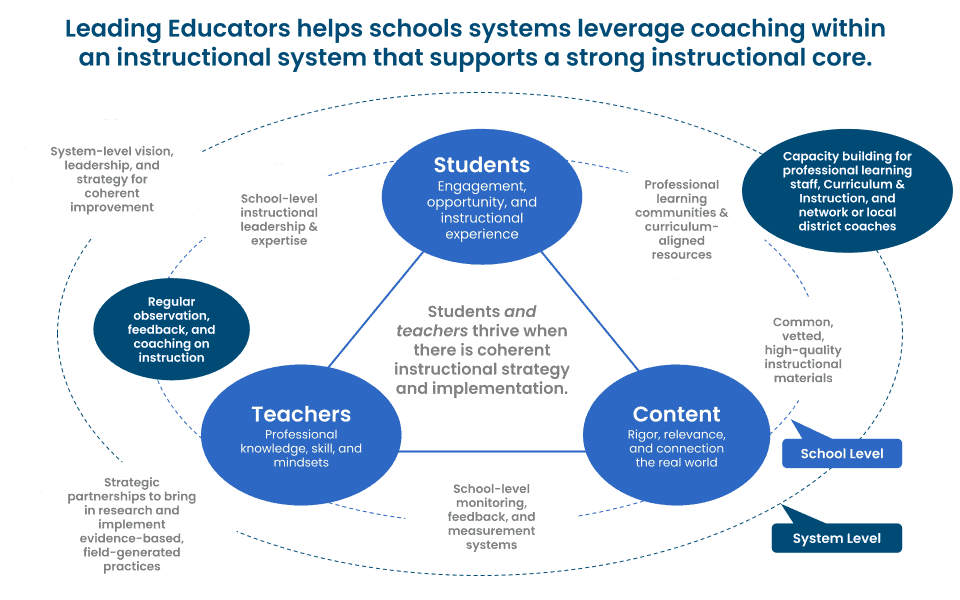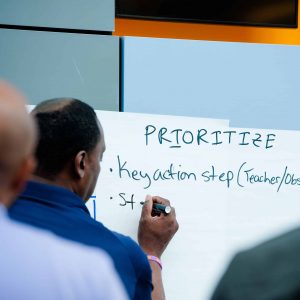
3 Factors That Make or Break Instructional Coaching
01/06/2024

Demands on teachers are changing in real time as schools work to accelerate learning, close stubborn opportunity gaps, and meet the needs of an evolving world.
To better leverage educators’ strengths and prepare all learners for the future, districts need to invest in their educators in ways that go beyond traditional one-size-fits-all professional development. That’s where instructional coaching can come into play. So, what do you need to know and plan for to get the most value out of your coaching program?
But First, What is Effective Instructional Coaching?
Coaching is an ongoing, collaborative, and non-evaluative process in which someone—an educator in this instance—gets personalized guidance and development around essential skills and knowledge from an expert. For educators, it’s a supportive relationship that exists to enhance teaching practices, improve student learning, and foster continuous learning habits.
Coaching can take many approaches, but the approach should always align with a specific purpose. In our work to develop instructional practice and leadership, we have often focused on four high-leverage instructional coaching approaches:
- Co-Planning: Collaborating with a teacher to identify key lesson content and develop specific instructional skills they can practice immediately.
- Modeling: Experienced teachers or coaches demonstrate or narrate effective instructional strategies followed by a debrief and opportunity to practice.
- Observation & Debrief: Observing and debriefing the way a teacher implements a mutually-defined instructional focus area; the coach and coachee celebrate effective practices and unpack the challenges of the focus area.
- Artifact Analysis: Examining evidence (e.g., student work, video of instruction, classroom transcript) to build a shared understanding of student or teacher growth.
You can learn more about these strategies in Coaching Approaches for Building Knowledge.
Why Prioritize Instructional Coaching?
While technical components of instructional strategy, like curricular materials, standards, and protocols, are critical inputs, teaching is also largely adaptive, human, and complex. Educators’ skills and knowledge grow more quickly and more durably when they have tailored support from expert mentors who have been in their shoes.
Instructional coaches are crucial in helping teachers shift their perspectives, deepen their subject area knowledge and skills, and reach their goals. Numerous studies highlight the benefits of curriculum-based coaching, but it’s equally important to understand what works best in implementation. Coaching is most effective when situated within a larger, coherent instructional strategy.

When Instructional Coaching Goes Wrong
In a piece for Education Week, renowned coach Elena Aguilar named a few key ways that teacher coaching programs fail.
- “Coaching” isn’t defined: No one knows or agrees on what it is and what coaches are supposed to do. Furthermore, success isn’t defined.
- Coaches haven’t been trained: Coaches are often catapulted into the role, having been “good teachers” but without any professional development in how to work with adult learners.
- Coaches aren’t coaching: Coaches are assigned to do dozens of random tasks that have nothing to do with adult learning. Subbing for absent teachers and coordinating testing schedules is not coaching.
- Teachers are forced to receive coaching: Coaching is something that’s “done to” teachers who are struggling or not performing well, and therefore, it’s seen as a punitive measure, a last resort before something very bad.
- Coaches think they’re better than everyone else. They think they know more about everything, that they’re here to save the day, and they wander the school halls casting judgment on teachers and administrators.
Drawing from these common challenges and what we have seen in our work to build instructional capacity, we offer more diagnoses of three factors that make or break teacher coaching programs.
What to Do and What to Avoid
#1: Set a Clear Purpose
- The detour: Often, teachers can access coaching as part of their professional development, but they don’t understand the intended purpose or objectives. That can lead to low uptake, skepticism, and a lack of follow-through. In other cases, teachers will show up but use coaching as a vent session rather than a space for working on specific goals.
- Why this happens: This challenge stems from various factors, including inadequate communication from leadership, the absence of a clear coaching strategy, and cultural attitudes about continuous learning and feedback.
#2: Expect and Preempt Fears About Evaluation and Punitive Coaching
- The detour: Coaching is associated with teacher evaluation in some contexts. Teachers (and sometimes school leaders) see coaches as evaluators who assess teachers’ performance and provide feedback on areas for improvement to inform high-stakes decisions about a coachee’s future. Teachers might feel apprehensive and less open to the level of reflection that effective coaching requires if they have experienced coaching primarily as a tool for assessing their competence.
- Why this matters: For teachers to be present and engaged in coaching, they can’t be concerned about the confidentiality of the conversations and how coaches might use their input. They need to believe and see that the coaching process is genuinely focused on their professional growth. Fears can result in underutilization, friction, and an unwillingness to learn and grow.
#3: Explicitly Connect Coaching to School Instructional Priorities
- The detour: Coaching can take on many purposes, but which will result in increased student learning? Often, coaching can focus on useful and important skills like classroom management, building relationships with families, and classroom culture without still connecting back to clear learning objectives. Suppose teachers don’t have the support to become experts in their content areas, their materials, and effective scaffolding. How can they ensure all students access grade-appropriate instruction and grasp essential building blocks?
- Why this matters: The core purpose of schools is great instruction. Standards set the bar for what students should know and be able to do at particular points in their journey, but they don’t tell teachers how to get there. That’s why focused instructional goals and tailored support around how to teach to the standards while maximizing joy and connection to the real world are key. With limited time, resources, energy, and attention, focus is critical so that teachers progress in their job’s most essential aspects.
Get Solutions and Take Action!
To find out how you can avoid these hurdles, get your free copy of our report, Get More Value from Your Teacher Coaching Program.
Want to take your school or district’s coaching program to the next level? Get in touch with us! We’ve coached thousands of school leaders and educators across the country, helping them build upon their unique strengths to ignite the potential in all students.
We can help you take your next step, too. Drop us a note, and we’ll have an LE team member reach out to learn more about your goals.








